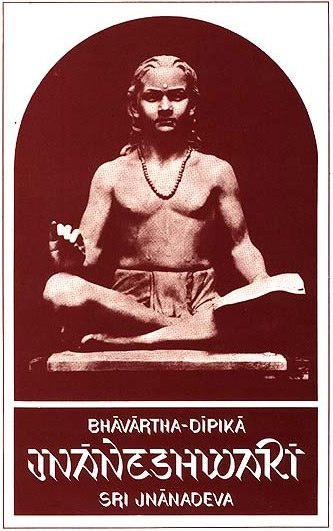Jnaneshwari (Bhavartha Dipika)
by Ramchandra Keshav Bhagwat | 1954 | 284,137 words | ISBN-10: 8185208123 | ISBN-13: 9788185208121
This is verse 12.3-4 of the Jnaneshwari (Bhavartha-Dipika), the English translation of 13th-century Marathi commentary on the Bhagavad-Gita.—The Dnyaneshwari (Jnaneshwari) brings to light the deeper meaning of the Gita which represents the essence of the Vedic Religion. This is verse 3-4 of the chapter called Bhakti-yoga.
Verse 12.3-4
Verse 12.3: “Those, on the other hand, who seek in service the Unmanifest Immutable that eludes (all) definition, that is Omnipresent, beyond thought, imperturbably set, unshakable and firm.
Verse 12.4: “By controlling the crowd of sense-centres and cultivating an ever-present equanimity of disposition: they also, intent upon securing the weal of all beings, attain just Mine own Self. (40)
Commentary called Jnaneshwari by Jnaneshwar:
And (there are) others, Oh Son of Pandu, that abide in the conception that they are themselves the Supreme Brahman, and cling to the non-manifest Immutable. Is it ever possible for the senses to attain that, where neither the mind can stick its nail nor the discerning power can get an entrance? Not only that; even profound concentration on spiritual meditation cannot have any trace of it; consequently no one can hold it in his grasp, nor could it exist in any form. It pervades everywhere and at all times, but even the thinking power becomes helpless there. It can neither be said to exist nor not to exist. It neither is nor is not, with the result that no means prove effective in attaining it: it neither moves nor gets removed and neither ends nor gets soiled. Yet those (others) have brought this under their control.
They have burnt the groups of sense-objects in the intensive fire of asceticism, and have with great fortitude put a restraint on the parched senses. They have, on the strength of their sense-control, twisted reversely the senses (which naturally are attracted towards external objects), and kept them shut up in the cave of their heart. They build the tower in the form of the posture ‘Mulabandha’, also called ‘Vajrasana’ (mūlabandha urpha vajrāsana) after securing properly the postures and attitudes (āsanamudrā), and after closing tightly the outlet of Apana wind. They snap the bonds of hope, blast the rocks of timidity and completely dispel the darkness of the sleep of ignorance.
With the help of the (internal) fire flames, resulting from the Mulabandha posture, they bum all the seven primary fluids and juices—the essential ingredients of the body (saptadhātu), and bombard all the diseases with the artillery in the form of six circles (cakra [cakre]—plexuses). Then they erect the brilliant torch in the form of the thrilling power, Kundalini, on the Adhar and with its Light, illuminate the entire region of the body right upto the head. They then close the nine gates of the senses, putting cross-bars and bolts in the form of determination, and keep open only the wicket for the Susumna Nadi (breath-passage). They give as oblations the head of the demon buffalo (after first cutting it) in the form of mind and also the ram (after first killing it) in the form of fancy, to the Goddess Chamundi in the form of the powerful life-wind.
The breath-passages Ida and Pingala—also called the Moon and the Sun—are then joined together by them, and then they secure speedily the water of the nectar of the seventeenth phase of the Moon, and ascending the flight of steps carved out in the breath-passage of Madhyama or Sushumna, they reach the Brahmarandhra (the apertue supposed to be at the crown of the head through which the soul takes its flight on death). Not only that: but ascending the flight of steps in the passage of Madhyama or Sushumna and putting under their arms the sky region of their head, they get themselves absorbed in the Supreme Brahman. And those that have in these ways secured equanimity of disposition, followed and made it their own, the rugged path of the study of Yoga discipline, in order to secure immediately the realization of the Supreme Brahman and have in exchange of their lives, secured instantaneously the qualityless and formless great void (śūnya—a term for Brahman),—Oh Kiriti, they also come unto me. Do not be under the impression that they secure anything more than this on the strength of the Yoga-discipline: if there is anything extra to their credit, it is only the toil.
